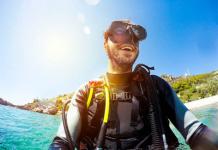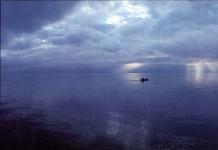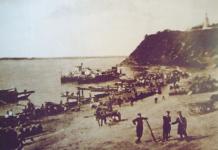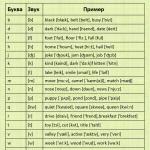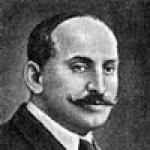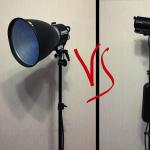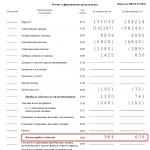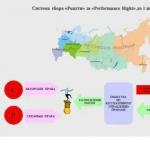The educational and training center of the Federal State Budgetary Institution "Marine Rescue Service" is the only state institution in Russia that carries out educational activities in the profession of "diver". Training is carried out according to basic vocational training programs and advanced training programs for the profession of “diver”, and additional professional advanced training and retraining programs in diving and areas related to the training of emergency rescue units and formations.
Training at the Educational and Training Center of the Federal State Budgetary Institution "Marine Rescue Service" is organized and carried out on the basis of a license from the Department of Education of the city of Moscow (No. 039302 dated April 20, 2018, series 77L01 No. 0010166). This license grants the Education and Training Center of the Federal State Budgetary Institution "Marine Rescue Service" the right to provide educational services for the implementation of educational programs by types of education, by levels of education, by professions, specialties, areas of training (for vocational education), by subtypes of additional education.
The educational and training center of the Federal State Budgetary Institution "Marine Rescue Service" is the only educational institution for vocational training in the profession of "diver" which is included in the Register of the Ministry of Labor and Social Protection of the Russian Federation as an accredited organization providing services in the field of labor protection, under registration number 5151 dated November 8, 2017 .
Training at the Educational and Training Center is carried out in the following areas:
As part of vocational training:
I. According to the main vocational training programs
1. According to the professional training program for the profession - “diver”:
1.1. Byqualifications - "4th category diver"
(Rescue and special diving work)
— Perform rescue diving operations when providing assistance to ships and aircraft in distress, as well as rescue diving operations related to rescuing people, examining and cleaning the bottom of water areas and water bodies for public recreation.
— Provide first aid to a diver in case of illnesses and injuries associated with professional activities.
— Perform special diving work to support scientific research, testing new models of diving equipment and work using special-purpose diving equipment.
No work experience required.
The training program for this qualification is as close as possible in form and content to the standards of the International Association of Diving Schools - InternationalDivingSchoolsAssociation– (hereinafter referred to as IDSA) – Level-1 (SCUBA) - Level 1.
For information : The standards developed by this association are quite identical and correlate well with the governing documents of such reputable organizations as the International Association of Marine Contractors ( IMCA ) and the British Administration (HSE).
1.2. By qualification - "5th category diver"
( Emergency, ship lifting and underwater technical work)
with the requirements for a specialist who has completed training in this program:
— Perform emergency diving operations related to the elimination of natural and man-made emergencies, not related to the rescue of people and ships.
— Perform underwater technical diving work during the construction, inspection, maintenance and repair of underwater parts of hydraulic structures, laying and repairing pipelines, cables and other communications, dredging, inspection and cleaning of waterways and water areas, as well as when lifting sunken objects.
— Perform ship-lifting diving operations when inspecting a sunken object, preparing it for lifting, when lifting and setting it afloat (shallow, shore, etc.).
— Perform ship diving work related to inspection, cleaning of fouling and elimination of damage to the underwater part of the ship’s hull and its underwater devices, inspection of the mooring area, as well as work inside flooded compartments when fighting for the survivability of the ship.
No work experience required.
The training program for this qualification is as close as possible in form and content to the standards IDSA - Level-2 (CommercialSCUBADiver) — Level 2.
2. According to advanced training programs "diver":
2.1. "diver from 4th category to 5th category diver"(3rd class diver, 1-2 groups of diving specialization)- By standards IDSA - Level-2 (CommercialSCUBADiver) — Level 2.
For training under this program, specialists with the qualification “4th category diver” are accepted, as well as divers with qualifications assigned by military educational institutions who have worked under water since the beginning of diving practice – at least 300 hours.
2.2. “Diver from 5th category to diver 6th category”(2nd class diver, 1st-2nd group of diving specialization) – according to standard IDSA - Level-3 (SurfaceSuppliedInchoreAirDiver) – Level 3.
We accept divers who are qualified as “5th category diver” and have worked underwater since the beginning of diving practice. — at least 1000 hours.
2.3. “Diver from 6th category to 7th category diver”(1st class diver, 1st-2nd group of diving specialization)– according to standards IDSA - Level-3 (SurfaceSuppliedOffshoreAirDiver) — Level 3+.
We accept divers who are qualified divers of the 6th category and have worked underwater since the beginning of diving practice. — at least 2000 hours.
II. Additional professional education
Implemented through:
3. Advanced training programs:
3.1 “Occupational safety during diving work”(Diving Operations Manager) - the program is intended for engineering and technical personnel permitted by decision of the enterprise administration to perform the duties of a diving operations manager.
3.2. “Occupational safety during diving descents”(head of diving descents) - the program provides training for divers of 6 and 7 categories and a diving specialist.
Training of employees and specialists specified in paragraphs. 3.1. and 3.2. labor protection within the scope of job responsibilities in accordance with the requirements of regulatory documents is carried out at least once every three years.
3.3. "Operators of diving pressure chambers". For training under this program, engineering, technical and medical personnel, divers of all categories, allowed by decision of the enterprise administration, can be involved in servicing diving pressure chambers.
3.4.“Operator servicing diving compressors charging equipment with compressed air”— the program provides for the training of both diving personnel and persons servicing diving descents (motor operators, mechanics).
3.5. "Underwater videographer". This training course is aimed at training engineering and technical personnel and divers of all levels.
3.6. “Specialist in surveying the underwater part of ships afloat.”
3.7. “Specialist in inspection of the underwater part of hydraulic structures.”
Training of specialists according to the programs specified in paragraphs. 3.6. and 3.7. provides training for divers with qualifications of at least 5th category and 1000 hours of underwater experience.
3.8. “First aid and basic medical support for diving descents”(medical support for diving descents) - this training program provides for the training of junior medical personnel, as well as, if there is an insufficient number of medical personnel at the enterprise, divers of 6 and 7 categories and a diving specialist.
Training for additional diving qualifications:
3.9. "Diver, welder, cutter"
3.10. "Deep Sea Diver"
According to clauses 3.9 and 3.10, divers with qualifications not lower than “5th category diver” and with experience are accepted working underwater since the beginning of diving practice - at least 1000 hours.
4.1. "Diving Specialist"– Divers of the 7th category are accepted who have a higher or secondary technical education with a technical profile and have experience working underwater – at least 2000 hours.
III. An annual test of knowledge of the “Inter-industry rules for labor protection during diving work”, safe work practices and instructions in force at work sites.
5. Testing the knowledge of “Inter-industry rules for labor protection during diving work”, safe work practices and instructions in force at work sites among divers and specialists whose activities are related to the provision of diving descents and work.
Based on this, the diving qualification commission (DQC) of the Education and Training Center conducts an annual test of theoretical knowledge and practical skills to confirm the qualifications acquired both in the main vocational training programs and in additional professional programs.
— divers of all qualifications;
- officials and specialists who have been trained in additional professional programs specified in paragraph 3.
INFORMATION ABOUT TRAINING SPECIALISTS
BY PROFESSION "DIVER"
(DIRECTION OF DIVING WORKS, DESCENTS AND THEIR SUPPORT)
V2019
I. Basic vocational training programs
- Professional training for the profession “Diver”:
|
Training course |
Period of study |
Price |
|
| "Diver 4th category" | 40 000,0 | ||
| "Diver 5th category" | March 15th | 60 000,0 | |
| 02 September | |||
| 28 of October | |||
2. Advanced training in the profession “Diver”:
|
Training course |
Period of study |
Price |
|
| "from 4th category to 5th category" | January 14 | 12th of February |
48 000,0 |
| 18th of Febuary | 21 March | ||
| March 27 | 25th of April | ||
| 03 September | 02 October | ||
| 09 October | 08 November | ||
| November 18th | December 18 | ||
| "from 5th category to 6th category" | January 21 | February 20th |
48 000,0 |
| March 04 | April 04 | ||
| April 15 | 22nd of May | ||
| 09 September | 08 October | ||
| October 15 | November 14 | ||
| November 25 | December 24 | ||
| "from 6th category to 7th category" | January 21 | February 20th |
48 000,0 |
| March 04 | April 04 | ||
| April 15 | 22nd of May | ||
| 09 September | 08 October | ||
| October 15 | November 14 | ||
| November 25 | December 24 | ||
SPECIAL OFFER
(at the CUSTOMER's choice)
Divers sent for training under advanced training programs from category 5 to category 6 and from category 6 to category 7 will be able to undergo training according to one of the programs additional professional education:
— Occupational safety during diving descents (Head of diving descents);
— First aid and basic medical support for diving descents.
The cost of training for the Additional Professional Education program is included in the cost of training for the advanced training program.
II. Additional professional education.
3. Advanced training programs*.
3.1. Initial training programs ( for Managers) :
3.2. Re-training ( for Managers) (at least once every three years)
3.3. Initial training programs (for Specialists):
|
Training course |
Period of study |
Price | |
| 5. |
15 000,0 |
||
| 6. |
15 000,0 |
||
| 7. |
15 000,0 |
||
| 8. |
15 000,0 |
||
| 9. |
15 000,0 |
||
| 10. |
(1 Week) |
20 000,0 |
3.4. Repeated training according to programs (for Specialists)(at least once every five years):
|
Training course |
Period of study |
Price |
|
| 11. | Operator of diving pressure chambers | ||
| 12. | Operator servicing diving compressors and charging devices with compressed air | ||
| 13. | Underwater videographer | ||
| 14. | Specialist in inspection of the underwater part of ships afloat | ||
| 15. | Specialist in inspection of the underwater part of hydraulic structures | ||
| 16. | First aid and basic medical support for diving descents |
10 000,0 |
NEW Offers (points 1-16)
come into force in 2019.
3.5. Training for additional diving qualifications:
* Training in advanced training programs (clauses 3.1-3.5) is provided upon request, provided that the group consists of at least 5 people.
4. Professional retraining program:
III. Annual test of knowledge of TB Rules and Instructions.
Form of study, terms of completion of programs and cost of training for them
when training specialists at the training centerin 2019
1. Professional training in the profession of “Diver”
2. Advanced training programs for the diver profession:
Additional professional education
3. Advanced training programs
Professional retraining program:
ADDITIONAL INFORMATION
Dear customers !
We kindly request Applications should be sent no later than two weeks before the start of classes.
When submitting an application for training, indicate:
- last name, first name, patronymic of candidates for training;
- type of educational program (the list is indicated in the basic information);
- address, telephone number of the student, copy of passport;
- for divers sent for training under advanced training programs - the number of diving hours from the beginning of diving practice;
- full bank details of the enterprise (organization);
- contact person and telephone number of the enterprise (organization) for solving organizational issues.
When enrolling for training, you must have :
- candidates for training in basic vocational training programs:
1.1 passport;
1.2 compulsory health insurance policy;
1.3 medical report based on the results of a preliminary (periodic) medical examination (examination) - *according to the Order of the Ministry of Health and Social Development of the Russian Federation dated April 12, 2011 No. 302 “On approval of the list of harmful (or) hazardous factors and work” - with the mandatory presence of a confirmed copies of the license of a medical organization to carry out medical activities in “Diving Medicine”;
1.4 certificate from psychoneurological and narcological dispensaries;
1.5 two photographs measuring 3x4.
- candidates for training in additional professional programs:
2.1 passport;
2.2 diver’s personal book; (for divers)
2.3 personal medical record of the diver;
2.4 compulsory health insurance policy;
2.5 certificate from psychoneurological and narcological dispensaries ( This certificate must be updated at least once every 5 years).
- divers for an annual test of knowledge of the Safety Rules and Instructions:
3.1 passport;
3.2 diver’s personal book;
3.3 the diver’s personal medical record with the conclusion of the diving medical commission;
3.4 document confirming completion of training in an additional professional program.
- In addition to the above, persons studying for the diver profession during practical classes must have:
4.1 set of workwear for open water activities (according to the season);
4.2 accessories for swimming pool activities.
Notes :
- Training in all programs is carried out taking into account 20% VAT.
- Divers who have experience working underwater since the beginning of diving practice are accepted for training in advanced training programs:
2.1 from 4th category to 5th category – divers of 4th category and divers with qualifications assigned by military educational institutions – at least 300 hours;
2.2 from 5th category to 6th category – 5th category divers – at least 1000 hours;
2.3 from 6th category to 7th category – 6th category divers – at least 2000 hours;
- Divers who have worked underwater since the beginning of diving practice are accepted for training in additional professional education programs:
3.1 deep sea diver – divers of 5, 6 and 7 categories – at least 1000 hours;
3.2 diving specialist - 7th category divers ( having higher education, technical profile) – at least 2000 hours.
- For courses according to the programs:
4.1 Occupational safety during diving descents (head of diving descents);
4.2 First aid and basic medical support for diving descents;
Accepted: divers of 6, 7 categories and diving specialists.
Class schedule: 38 hours per week.
Persons who have completed training at the Education and Training Center, State-issued documents are issued.
There is a comfortable hotel at the Training Center. Accommodation cost from 650 rubles/day.
Directions to the Educational and Training Center — by metro to the station — "T E H N O P A R K"
( From June to September there is no training at the training center ) .
We invite you to mutual cooperation.
Head of Training Center V.A. Zgursky
"APPROVED" _____________________________ (manager position) _____________________________ (name of organization) _____________/ _____________/ "____"_______________ ____ Mr. M.P.
JOB DESCRIPTION
Diver of the 5th category
1. GENERAL PROVISIONS
1.1. This job description defines the functional responsibilities, rights and responsibilities of a Diver of the 5th category (hereinafter referred to as the Employee) in “______________” (hereinafter referred to as the Employer).
1.2. An employee is appointed to a position and dismissed from a position in the manner established by current labor legislation by order of the head of the Employer.
1.3. The employee reports directly to ___________________________.
1.4. A person with specialized secondary education and work experience in the position of _________ for at least ___ years is appointed to the position of Employee.
1.5. The employee must know:
Rules for diving descents;
Construction of instrumentation and tools used when working under water;
Methods and technology for surveying water areas, laid pipelines and cables;
Technology for searching and lifting objects under water;
Rules for drawing up diagrams, sketches and reports based on survey results;
Methods for developing underwater soil, techniques for filling and leveling underwater beds, straightening and tamping the rail tracks of ship-lifting structures;
Rules for installation and joining of water intake and outlet heads, blocks and arrays;
Methods of obtaining seafood by diving, technology for observing industrial fishing gear, types of seafood and dangerous marine animals and means of protection against their attack;
Rules and sequence of inspection of the hulls of sunken ships;
Methods for measuring holes in hulls and damage to hydraulic structures; methods of metalworking, carpentry and rigging;
Methods for identifying faults and methods for carrying out preventive repairs of diving equipment and means of providing diving descents;
Labor legislation;
Rules on labor protection, industrial sanitation and fire safety;
Rules for the use of personal protective equipment;
Requirements for the quality of work (services) performed and for the rational organization of labor in the workplace.
1.6. During the period of temporary absence of the Employee, his duties are assigned to ___________________________.
2. FUNCTIONAL RESPONSIBILITIES
2.1. The employee performs:
2.1.1. Inspection of the underwater part of hydraulic structures, pipelines and cables laid in underwater trenches, searching for them using route finders and determining the depth of their occurrence.
2.1.2. Inspection of stone slopes of canals, locks, dams, dams and other structures for mooring ships, floating signs, track conditions and navigation equipment.
2.1.3. Development of underwater soil using hydro-washing agents for the purpose of deepening and cleaning the bottom.
2.1.4. Rough leveling of underwater stone-crushed stone and sand beds under the foundations of hydraulic structures or underwater objects.
2.1.5. Drilling holes under water, sawing wooden structures, installing tenons on piles, placing wooden plugs in holes and gaskets in gaps in wooden structures, etc. work.
2.1.6. Installation of heads and arrays weighing up to 20 tons.
2.1.7. Laying concrete mixture under water.
2.1.8. Slinging and unslinging objects under water.
2.1.9. Maintenance of scientific research work: carrying out a preventive inspection of the vessel, cleaning the underwater part of the hull, propellers, underwater ways of slips and slipways from fouling and blockages; performing simple installation, plumbing, carpentry and rigging work under water.
2.1.10. Extraction of seafood, conducting underwater observations of industrial fishing gear.
2.1.11. External examination of the hulls of sunken ships.
2.1.12. Unloading cargo from the hull of a sunken ship that does not require balancing.
2.1.13. Removing sediment from the hull of a sunken ship.
2.1.14. Inspection and cleaning of water areas intended for public recreation.
2.1.15. Carrying out search operations related to the detection and lifting of victims from the water using various types of rescue equipment.
2.1.16. Charging diving equipment with compressed air.
3. RIGHTS OF AN EMPLOYEE
The employee has the right to:
3.1. Providing him with work stipulated by the employment contract.
3.2. A workplace that meets state regulatory requirements for labor protection and the conditions stipulated by the collective agreement.
3.3. Complete reliable information about working conditions and labor protection requirements in the workplace.
3.4. Professional training, retraining and advanced training in the manner established by the Labor Code of the Russian Federation and other federal laws.
3.5. Receiving materials and documents related to its activities, familiarizing itself with draft decisions of the Employer’s management relating to its activities.
3.6. Interaction with other departments of the Employer to resolve operational issues of their professional activities.
3.7. Submit proposals on issues related to your activities for consideration by your immediate supervisor.
4. RESPONSIBILITY
The employee is responsible for:
4.1.1. Failure to perform or improper performance of one's duties as provided for in this job description - in accordance with current labor legislation.
4.1.2. Violation of safety rules and labor protection instructions.
Failure to take measures to suppress identified violations of safety, fire and other rules that pose a threat to the activities of the Employer and its employees.
4.1.3. Offenses committed during the period of its activities are in accordance with current civil, administrative and criminal legislation.
4.1.4. Causing material damage - in accordance with current legislation.
5. WORKING CONDITIONS
5.1. The Employee’s work schedule is determined in accordance with the Internal Labor Regulations established by the Employer.
5.2. Due to production needs, the Employee may go on business trips (including local ones).
This job description has been developed in accordance with _________ _________________________________________________________________________.
(name, number and date of the document) AGREED BY: _________________________________________ (person endorsing the job description) ______________/______________________________/ "____"____________ ____ (signature) (full name) I have read the instructions: ___________/_____________/ "____"________ ____ (signature) (full name)
The professional holiday Diver's Day is celebrated in Russia on May 5. Petitions and petitions from representatives of diving organizations contributed to the Russian government deciding to establish this day.
History of the Diver's Day holiday
This holiday, Diver's Day, was created in 2002. On this day in Kronstadt in 1882, the world's first diving school was opened. This was done by order of Emperor Alexander III.
At that time, there were no analogues of such schools in the world, so foreigners began to come to it. Moreover, studying there was considered very honorable. Divers from Russia were known throughout the world. And, of course, with their work, divers deserve their own holiday, May 5, Diver's Day.
Profession diver
Diver's Day is a great opportunity to talk about the profession of a diver.
Ordinary people know very little about this profession, because... divers are not that common. But everyone understands that this work is not easy and involves great risk. This profession requires courage, endurance and excellent health.

The work of divers is used in a variety of areas; they are engaged in ship repair, rescue work, maintenance of underwater structures, hydroelectric power stations, oil platforms, as well as inspection of natural bodies of water.
Very often, people in this profession have to work in all weather conditions; they are constantly faced with pressure changes when diving.
Modern divers work in comfortable wetsuits, but previously they had to work in uncomfortable suits, in which it was even difficult to move underwater. The diver's profession is one of the professions that has particularly harmful and particularly difficult working conditions.
A diver is a specialist who performs various types of underwater work. By their nature, all diving work can be divided into rescue, ship-lifting, ship, underwater technical, rescue and special.
For a long time, the Russian school was considered the best in the world and trained excellent professionals in their field. Currently, the successor to this school is the Naval Engineering Institute named after. Peter the Great. It was formed in 1998.
Diving in Russia
Diving in Russia existed at the beginning of the 18th century. Mentions of the use of divers in some economic work are found in documents of that time.
In 1861, a decree was issued that all Russian warships that went on foreign voyages were required to have special diving equipment on board.
In 1871, the Society for Providing Relief for Shipwrecks was created. His main activities were the rescue of people and ships, as well as the study of the water resources of our country.
In 1873, an autonomous diving apparatus was designed by naval officer A. Khotinsky. It used oxygen for breathing. Lieutenant Mamota in 1878 created an autonomous diving apparatus used for military purposes.
Thus, the need for professionally trained personnel soon arose. Therefore, the “Diving School for Officers” was opened in Kronstadt. This school has received many awards.
In 1907, not only ships, but also submarines were equipped with diving equipment.

In 1923, the famous EPRON (Special Purpose Underwater Expedition) began operating in our country. This organization has been engaged in ship-lifting, rescue and diving operations for many years. It was its divers in the 30s who were able to dive to the greatest depths.
By the 50s, diving equipment was created that made it possible to dive to a depth of 200 meters or more.
In 1968, an experiment was conducted on long-term stay of people at a depth of one hundred meters. Similar experiments have been carried out for many years and have always been successful.
During this work, a technique for providing assistance to submarines that had suffered an accident was even tested. All this work was carried out using exclusively Soviet diving equipment.
In 1990, our divers learned to descend to a depth of 500 m, staying there for 10 days.
Diver suit
It is believed that the world's first diving suit was invented by August Siebe. However, he was only one of several inventors of the time who were involved in conducting such experiments.
For example, in 1823, brothers John and Charles Dean received a patent for a “smoke apparatus” that was intended for use by firefighters. Based on it, 5 years later they created “Dean’s patented diving suit.” It consisted of a helmet and a heavy suit that could protect against cold water. This suit can be called quite safe, but this only applies to the diver being in an upright position. And when he fell, there was a threat to life, because the helmet began to quickly fill with water. It was very difficult to avoid falls.

August Siebe perfected this "diver's clothing". He tightly connected the helmet to the suit, which reached to the waist.
In 1840, the diving suit was equipped with a release valve. It was from this time that we can talk about the appearance of a full-length diving suit. It was successfully used by the English Royal Engineer Troops during one important operation.
Colonel William Paisley, who commanded it, recommended using August Siebe’s equipment when carrying out all underwater work. This served as good advertising, and soon such a diving suit began to be used all over the world.
Today, divers work on military and civilian vessels, and their work is greatly needed in many industries and scientific research.
Traditions for the holiday
On May 5, Diver's Day, various ceremonial events dedicated to this day are held. They are attended by diving veterans, sports competitions, competitions for carrying and putting on equipment, etc. are held.
It should be noted that diving has become increasingly popular lately. But don’t confuse diving with diving work. Diving is diving for pleasure, and being a diver is a profession.
When the front porthole is in place and turned, the diver standing at the signal lets the person descending know with a palm strike that everything is ready for descent. The diver should not immediately rush into the water, but, holding the handrail of the ladder, descends to the last step and only after acquiring some buoyancy can he release the handrail. After this, the diver standing at the signal leads the descending diver away from the ladder to the side and, as soon as the water covers the helmet, pauses the descent so that the diver checks his equipment again. The diver standing at the signal also carefully examines the lowered diver at this time and, making sure that everything is in order and there is no air leaking anywhere, begins the descent. This moment is recorded in the log as the beginning of the descent.
If underwater lighting is required for work, then the light bulb is supplied to the diver while he is at the side of the longboat, and it lights up only after being lowered into the water. When lowering a diver, the diver standing on the signal etches the signal end, intercepting it “hand by hand.” For beginner divers, the descent speed should not exceed 4 m/min. For experienced ones, it is much larger - 14 m in the first minute, with a gradual increase in subsequent minutes.
Divers should be trained until they reach a descent speed of 55 m within 3 minutes. Through long-term training, you can achieve greater lowering speed. For example, the American Navy recently achieved a diver's descent speed of 61 g within 40 seconds.
The person monitoring the pressure gauge readings must report to the diver standing at the signal about the change in pressure after 1 m.
If the diver gives a signal to stop, the descent must be stopped, after which the diver is raised 1-2 m. Further descent is carried out only upon receiving a signal from the diver to continue the descent; after this the descent is made more slowly. As the diver's depth increases, the air supply must increase accordingly. As soon as the diver reaches the ground, he must inform the diver standing at the signal, otherwise the latter must himself ask him about it.
As soon as the diver reaches the ground, he must listen to see if the air is flowing well and in sufficient quantity, after which he gives a signal that he is on the ground. If air is supplied in insufficient quantities, it requires an increase in supply. If the slightest dizziness or nausea occurs, the diver should request immediate rise. The diver standing on the signal is prohibited from giving too much slack to the signal end in order to constantly feel the diver; he should not be distracted by anything, but concentrate all his attention on the signals given by the diver. If for some reason he needs to change his shift, then, having received permission from the work manager, he must, in the presence of the intervening diver, ask the diver how he is feeling; after this, he passes the signal end to the intercessor and, when he, in turn, receives a response from the diver, he can consider himself free. Air should be supplied to the diver in an amount of 40 l/min. The pump handles must be rotated smoothly, at a speed corresponding to the depth of descent of the diver.
If the telephone connection with the diver is interrupted for some reason, this should be immediately reported to the work manager. The diver standing on the signal asks the diver at the signal end if everything is fine with him, and if there is no response to the double request, he must immediately raise the diver. A diver working on the ground, moving a considerable distance from the place of descent, should not take up much slack in the hose and the signal end, so as not to tangle them in something. If during the work the hose or signal end becomes tangled or pinched, the diver immediately takes measures to clear them. A pinched or tangled signal end can be cut in such a way that the cleared ends can be tied with a straight knot. When the hose and signal end are so tangled that the diver cannot untangle them himself, he must request the assistance of a second diver. When descending, the latter is equipped with a sharp knife and needle-nose pliers. If the joint efforts of both divers fail to free the hose, then, having cleaned the signal end as indicated above and having filled the shirt with a sufficient amount of air, the diver cuts the hose, stretches and bites the spiral with needle-nose pliers, after which he gives an alarm signal.
Another method is less desirable, but also possible: the diver sequentially cuts the signal end, the tailpiece, the hose and the weight braces and, having thus acquired positive buoyancy, is thrown to the surface, being careful not to bleed off the air from the head valve.
If a forced rapid ascent of a diver is made from a depth of more than 12.8 m, it is necessary to immediately lower the diver again to the previous depth and, after holding him there for one minute, perform the ascent in accordance with existing rules.
POU St. Petersburg Maritime School RO DOSAAF RUSSIA is a public organization of DOSAAF RUSSIA carrying out educational activities in the basic vocational training programs for the profession of “diver”, additional professional programs for advanced training, training and retraining in areas related to the activities of emergency rescue units and formations.
The right to provide educational services for the implementation of educational programs by type of education, by level of education by profession, specialty, area of training (for vocational education), by subtypes of additional education is granted by the Committee on Education of St. Petersburg, license No. 2119 dated September 01, 2016
Based on this license, the St. Petersburg Maritime School carries out educational activities:
As part of vocational training:
I. For basic vocational training programs
1. According to the professional training program for the profession - “diver”:
1.1. By qualification "4th category diver"
(Rescue and special diving work)
- Perform rescue diving operations when providing assistance to ships and aircraft in distress, as well as rescue diving operations related to rescuing people, examining and cleaning the bottom of water areas and water bodies for public recreation.
- Provide first aid to a diver in case of illnesses and injuries associated with professional activities.
- Perform special diving work to support scientific research, testing new models of diving equipment and work using special-purpose diving equipment.
No work experience required.
1.2. By qualification - "5th category diver"
( Emergency, ship lifting and underwater technical work)
with the requirements for a specialist who has completed training in this program:
- Perform emergency diving operations related to the elimination of natural and man-made emergencies, not related to the rescue of people and ships.
- Perform underwater technical diving work during construction, inspection, maintenance and repair of underwater parts of hydraulic structures, laying and repair of pipelines, cables and other communications, dredging, inspection and cleaning of waterways and water areas, as well as when lifting sunken objects.
- Perform ship-lifting diving operations when inspecting a sunken object, preparing it for lifting, when lifting and setting it afloat (shallow, shore, etc.).
- Perform ship diving work related to inspection, cleaning of fouling and elimination of damage to the underwater part of the ship's hull and its underwater devices, inspection of the mooring area, as well as work inside flooded compartments when fighting for the survivability of the ship.
No work experience required.
2. According to advanced training programs “diver”:
2.1. "diver from 4th category to 5th category diver"(3rd class diver, 1-2 groups of diving specialization)–
For training under this program, specialists with the qualification “4th category diver” are accepted, as well as divers with qualifications assigned by military educational institutions who have worked under water since the beginning of diving practice – at least 300 hours .
2.2. “Diver from 5th category to diver 6th category”(2nd class diver, 1-2 groups of diving specialization, additional qualification diver-carver)
We accept divers who are qualified as “5th category diver” and have worked underwater since the beginning of diving practice.at least 1000 hours.
2.3. “Diver from 6th category to 7th category diver”(1st class diver, 1-2 groups of diving specialization, additional qualification: diver-welder)
We accept divers who are qualified divers of the 6th category and have worked underwater since the beginning of diving practice.at least 2000 hours.
2.4. “Diver from 7th category to diver 8th category”– Divers of the 7th category are accepted who have a higher or secondary technical education with a technical profile and have experience working underwater – at least 2500 hours .
3. Advanced training programs:
3.1. "Diver, welder, cutter"
We accept divers who have qualifications of at least 5th category diver and have worked underwater since the beginning of diving practiceat least 1000 hours.
3.2 Head of diving operations— the program is intended for engineering and technical personnel permitted by the decision of the enterprise administration to perform the duties of a diving operations manager.
3.3 Head of diving descents– the program provides training for divers of 6 and 7 categories and a diving specialist.
Training of employees and specialists specified in paragraphs. 4.2. and 4.3. labor protection within the scope of job responsibilities in accordance with the requirements of regulatory documents is carried outat least once every three years.
"Annual technical minimum."
3.4. According to requirements “Inter-industry rules for labor protection during diving work”, Further - " Rules“, regular testing of knowledge of labor protection, knowledge of these “Rules”, safe work practices and instructions in force at work sites is carried out.
Based on this, the diving qualification commission (DQC) of the Education and Training Center conducts an annual test of theoretical knowledge and practical skills to confirm the qualifications acquired both in the main vocational training programs and in additional professional programs.
- divers of all qualifications;
- officials and specialists trained in additional professional programs.
INFORMATION ABOUT TRAINING SPECIALISTS VPOUMorskaya school St. Petersburg RO DOSAAF RUSSIA
(Schedule)
I. Basic vocational training programs:
1. Vocational training programs:
|
Training course |
Form of study |
Timeframe for completing the program |
Period of study |
|
|
"4th category diver" |
full-time |
210 hours |
||
|
"5th category diver" (3rd class diver, 1st-2nd specialization groups) |
full-time |
307 hours |
||
|
According to a separate plan (by request) |
||||
2. Advanced training programs:
|
Training course |
Form of study |
Timeframe for completing the program |
Period of study |
|
|
"from 4th category to 5th category" (diver 3 classes 1-2 groups of specialization |
full-time |
250 hours |
||
|
"from 5th category to 6th category" (2nd class diver, 1st-2nd specialization groups, additional qualification diver-carver) |
full-time |
|||
|
"from 6th category to 7th category" (1st class diver of 1-2 specialization groups, additional qualification diver-welder) |
full-time |
248hours |
||
3. Advanced training program:
VPOU SPb Maritime School, in addition to training specialists in the main professional training program, is carried out:
4 “Annual technical minimum”
Training is provided without VAT 18%.
Class schedule: 38 hours per week.
Persons who have completed training at the St. Petersburg Maritime School are issued documents of an all-Russian standard.
1. The number of students in each course is from 5 to 15 people.
2. Information on the procedure for submitting applications for training.
In the application indicate:
- last name, first name, patronymic of candidates for training;
- qualifications of divers sent to improve their skill level and the number of diving hours from the beginning of diving practice
- training course for additional professional development programs, according to the information provided;
- full bank details of the enterprise (organization);
- contact person and telephone number for solving organizational issues.
Applications must be submitted no later than two weeks before the start of classes.
3. Information about the availability of documents for candidates upon admission:
3.1. For main vocational training programs:
- passport;
- conclusion of a preliminary medical examination in accordance with order of the Ministry of Health and Social Development of Russia No. 302n dated April 12, 2012 (Appendix form No. 5);
- certificate from psychoneurological and narcological dispensaries;
- two photographs measuring 3x4.
3.2. for advanced training programs:
- passport;
- travel certificate;
- diver's personal book;
- diver's personal medical record;
- compulsory health insurance policy;
- certificate from psychoneurological and narcological dispensaries (updated once every 5 years).
3.3. for the annual technical minimum:
- passport;
- travel certificate;
- diver's personal book;
- certificate (certificate) of graduation from an educational institution in an additional professional program;
- the diver’s personal medical record with a mark on completion of the annual examination;
5. There is no dormitory at the school. There is a dormitory near the school; the cost of living is 350 rubles per day.
